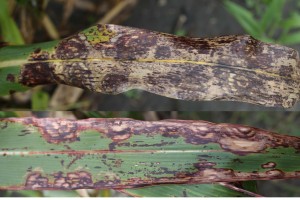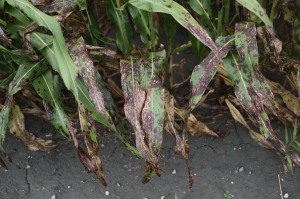This tip was provided by:
Dr. Gary Odvody, Plant Pathologist, Texas A&M AgriLife Research, Corpus Christi, 361-265-9201, godvody@ag.tamu.edu (compiled by Calvin Trostle)
Coastal Bend
Zonate Leaf Spot in Grain Sorghum—2015 Observations
Zonate leaf spot (ZLS) produces unusual leaf disease symptoms on grain sorghum. You may not notice it at low levels but if incidence is pronounced this fungal disease produces unique and strongly expressed leaf symptoms (Fig. 1). Zonate leaf spot (Gloeocercospora sorghi) was common on grain sorghum in the Texas Coastal Bend in 2015 due to season long wet conditions through about July 1 when rains abruptly ended. Under conditions conducive to zonate leaf spot, the disease often develops as multiple lesions per leaf which coalesce to eventually kill the leaf tip and most of the entire leaf (Fig. 1, 2).

Fig. 2. Top Leaf: Multiple zonate lesions that have coalesced to kill most of the leaf blade, especially from mid-leaf to the tip. Bottom Leaf: Earlier leaf margin pattern of lesion development which may eventually coalesce across the leaf blade. (Gary Odvody).
As grain sorghum plants mature, leaves lose much of their resistance to pathogens so this disease can cause lots of foliar damage under disease-conducive conditions from mid to late season. However, ZLS typically does not cause economic loss of grain yield in Texas. Loss of leaves due to ZLS might affect forage yields in sorghum family forages although actual forage losses have not been documented. Under the multiple planting dates of 2015, sorghum maturing after July 1 in the lower coastal bend of Texas had progressively lower zonate leaf spot as drier, hotter conditions began to prevail.
Today’s grain sorghum hybrids and zonate leaf spot: Plant pathologists and sorghum breeders collaborate to eliminate sorghum lines and hybrids that are highly susceptible to foliar diseases including ZLS. This disease is present across South Texas in most years but generally at levels much lower than observed in 2015. The disease usually becomes most noticeable late in the season when the potential effect on yield is minimal. Except for avoiding highly susceptible hybrids there are no practical or necessary management strategies for ZLS on Texas sorghum.
For further information on this disease and additional photographs contact Dr. Odvody.









